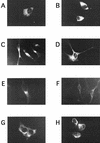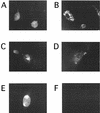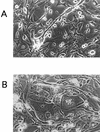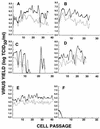Acute and persistent infection of human neural cell lines by human coronavirus OC43
- PMID: 10074188
- PMCID: PMC104098
- DOI: 10.1128/JVI.73.4.3338-3350.1999
Acute and persistent infection of human neural cell lines by human coronavirus OC43
Abstract
Human coronaviruses (HuCV) are recognized respiratory pathogens. Data accumulated by different laboratories suggest their neurotropic potential. For example, primary cultures of human astrocytes and microglia were shown to be susceptible to an infection by the OC43 strain of HuCV (A. Bonavia, N. Arbour, V. W. Yong, and P. J. Talbot, J. Virol. 71:800-806, 1997). We speculate that the neurotropism of HuCV will lead to persistence within the central nervous system, as was observed for murine coronaviruses. As a first step in the verification of our hypothesis, we have characterized the susceptibility of various human neural cell lines to infection by HuCV-OC43. Viral antigen, infectious virus progeny, and viral RNA were monitored during both acute and persistent infections. The astrocytoma cell lines U-87 MG, U-373 MG, and GL-15, as well as neuroblastoma SK-N-SH, neuroglioma H4, oligodendrocytic MO3.13, and the CHME-5 immortalized fetal microglial cell lines, were all susceptible to an acute infection by HuCV-OC43. Viral antigen and RNA and release of infectious virions were observed during persistent HuCV-OC43 infections ( approximately 130 days of culture) of U-87 MG, U-373 MG, MO3.13, and H4 cell lines. Nucleotide sequences of RNA encoding the putatively hypervariable viral S1 gene fragment obtained after 130 days of culture were compared to that of initial virus input. Point mutations leading to amino acid changes were observed in all persistently infected cell lines. Moreover, an in-frame deletion was also observed in persistently infected H4 cells. Some point mutations were observed in some molecular clones but not all, suggesting evolution of the viral population and the emergence of viral quasispecies during persistent infection of H4, U-87 MG, and MO3.13 cell lines. These results are consistent with the potential persistence of HuCV-OC43 in cells of the human nervous system, accompanied by the production of infectious virions and molecular variation of viral genomic RNA.
Figures





References
Publication types
MeSH terms
LinkOut - more resources
Full Text Sources
Research Materials

